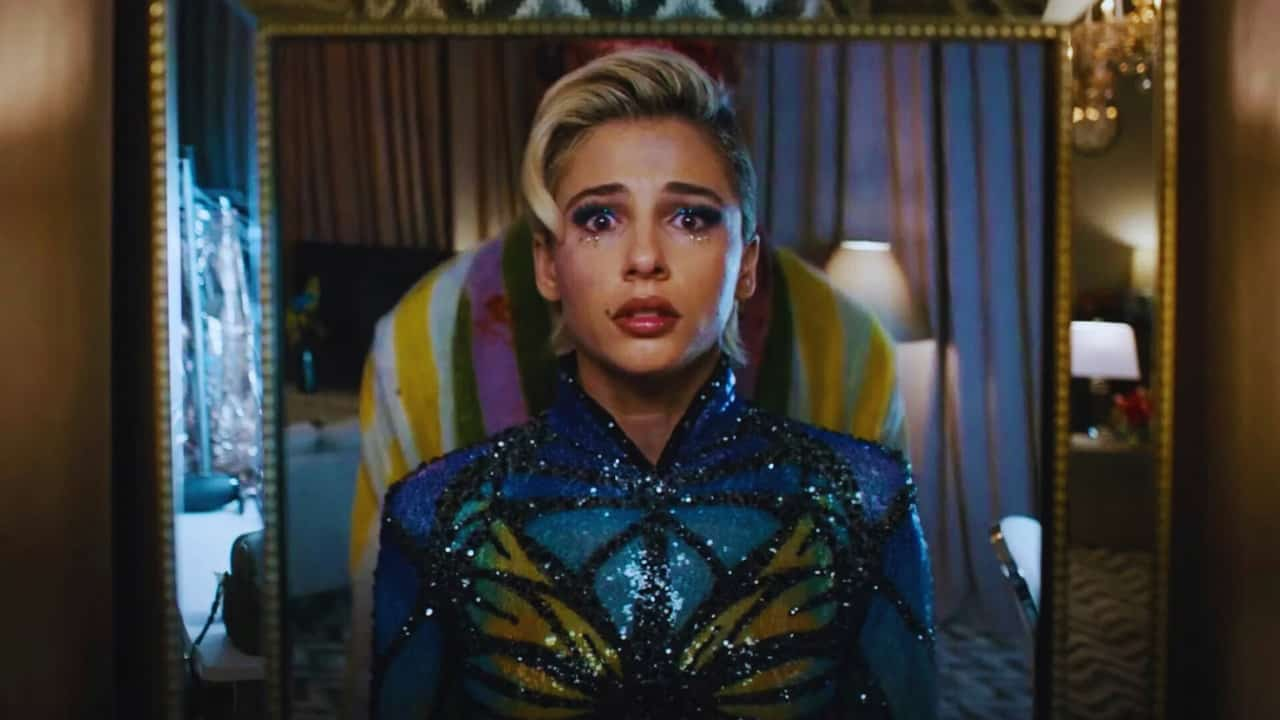The horror franchise that introduced audiences to a sinister, smile-obsessed entity is back with a biting new sequel that sets its sights on the high-pressure world of pop music stardom.
“Smile 2,” the follow-up to the 2022 sleeper hit “Smile,” once again taps into writer-director Parker Finn’s penchant for blending chilling supernatural thrills with sharp social commentary. This time, Naomi Scott’s ferocious intensity as Skye Riley, a fictional pop superstar, is the target of the shapeshifting demon at the heart of the story.
Skye’s journey differs significantly from the traumatized psychiatric hospital in the first film. As the sequel opens, the haunting presence has already infiltrated the seedy underworld, leading to a gruesome death that sets the stage for its latest target.
“Do you believe in weird stuff?” the doomed drug dealer asks Skye in an early scene, unwittingly foreshadowing the horrors to come.
Those horrors soon come knocking on Skye’s door as the smiling specter latches onto the already stressed-out pop star. Fresh off a devastating car accident that killed her famous boyfriend and sparked a Vicodin addiction, Skye is now grappling with the pressures of a high-stakes comeback tour, a pushy stage mother, and a demanding record label executive.
“Smile 2” thrives when it trains its satirical eye on the cutthroat world of the music industry, where Skye’s mental and physical well-being are constantly deprioritized in service of the machine.
One painfully cringeworthy moment forces Skye to deliver, echoing the hollow platitudes of so many celebrity apologies, “I let you down, and I promise this will never happen again.” Elsewhere, when Skye’s inner turmoil becomes dangerously apparent, her stage mother offers only a dismissive “You need to stay hydrated” response.
Naomi Scott’s powerful performance is the linchpin that holds this delicate balance of horror and humor together. Skye’s seamless transition from diva-like bravado to wrenching vulnerability, along with her smeared makeup and wild-eyed desperation, are a stark contrast to the polished perfection the industry demands.
One reviewer writes, “Skye manages to pour her humanity into the role—diva, whimpering, defiant, strung out, panicked.” “She even sings on the soundtrack—songs that are credible hits.”
Finn, who also directed the first “Smile,” makes the most of this setting, weaving in clever jabs at the performative nature of celebrity culture. Drew Barrymore’s cameo as a vapid, self-help-spouting talk show host is particularly noteworthy, highlighting the expected façade of authenticity among stars.
“Smile 2” may not have the same visceral impact as its predecessor—Finn acknowledges that the signature scare tactics feel “a little depleted” this time around—but it still delivers some inspired sequences of terror. A standout scene pits Skye against a troupe of phantom backup dancers, their synchronized movements and unsettling poses ramping up the dread.
Ultimately, though, the real horror lies in the relentless pressure that Skye faces, both from the supernatural entity and the industry that seeks to exploit her. It’s a timely commentary on the dark side of fame, set against the backdrop of a mainstream horror franchise that has proven itself adept at blending scares with social relevance.
“Finn has become a much more assured filmmaker and uses humor so well here, from nasty gangsters enjoying pumpkin Frappuccinos to our heroine Googling, ‘Does vomit have DNA?'” writes one critic.
As Skye navigates the increasingly surreal and terrifying events, the film builds to an ending that, in the words of another reviewer, “deserves every crooked smile it earns.” It’s a conclusion that feels both shocking and inevitable, a fitting summation of a sequel that deftly balances the demands of franchise-building with incisive social commentary.
With “Smile 2,” Finn has proven that the creepy, grinning entity at the heart of this horror universe is more than just a jump-scare machine. It’s a manifestation of the deeper anxieties that plague our celebrity-obsessed culture and a reminder that sometimes the scariest monsters aren’t the supernatural ones, but the ones we create ourselves.
